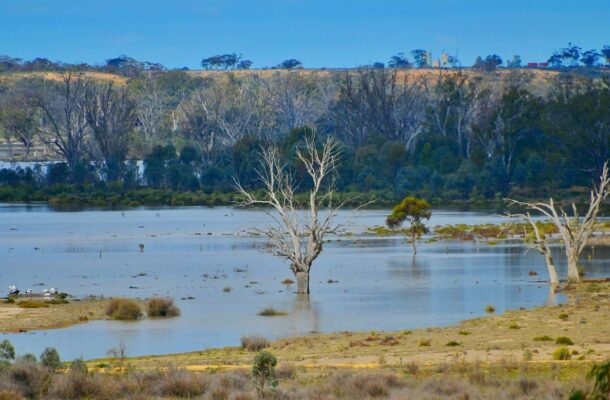The curious death of the Murray-Darling

For more than a decade, the Australian government poured billions into the country’s biggest river system, trying to protect it from irreversible damage.
But instead of saving the river, the Murray-Darling Basin Plan serves as a cautionary tale for other regions.
The Murray-Darling Basin, a river system spanning over a million square kilometres, stretches over four states and one territory on Australia’s eastern side. It is often referred to as “Australia’s food bowl” and the farming centre of the country.
In 2007, amid widespread and devastating decade-long drought, the Australian Government set aside AUD$10 billion in funding and enacted the Water Act, a policy to protect the basin.
The Water Act gave rise to the Murray-Darling Basin Plan, a 2012 strategy that — among other things — was supposed to ensure sustainable water use from the basin and to “protect, restore and provide for” its natural environment.
The plan has not met its potential. It has been described as “destroying rural communities” by lobbyists and “failing to deliver for the environment” by researchers and some communities. Former prime minister John Howard, initiator of the Water Act, said in 2021 that the basin has suffered from “very, very bad administration over the years by governments of both persuasions.”
On paper, it doesn’t make sense: Australia is a stable democracy with a robust public service. It could be a model case study of sustainable river management.
Instead, it has been derailed by political dispute and cross-border in-fighting. A set of reforms brought in at the end of 2023 offers a chance to improve the basin’s fortunes, but it has to undo a saga that has stretched over a decade.
The Basin Plan
The Basin Plan was an agreement between two levels of government – Australia’s federal government, and individual state and territory governments. The federal government had, earlier, created a statutory body, called the Murray-Darling Basin Authority, to implement the agreed upon plan.
From the outset, there was controversy.
The Authority’s 2012 Basin Plan featured a notable departure from the 2010 “guide to the proposed Basin Plan”, a document from the same body which provided much of the modelling and science for the final product.
In 2010, the guide estimated that 3,856 billion litres per year needed to remain flowing in the river system to meet the Water Act’s environmental goals. Even then, the plan noted, it was highly uncertain whether this cut to water extractions would deliver healthy rivers.
When the Basin Plan arrived two years later, it told a different story: it said river water extractions should only be reduced by 2,750 billion litres per year — 40 percent less than the minimum suggested in 2010.
There were more points of difference.
The 2012 Basin Plan almost doubled allowable bore-water extractions without properly considering effects it may have on water quality and surface water. The plan also failed to account for climate change and increasing droughts when considering the sustainable diversion limits for water extractions.
In a 2018 Royal Commission, a former official at the Murray-Darling Basin Authority shed light on the difference between the 2010 and 2012 documents. Speaking under oath, water planner David Bell said there was “a very clear understanding” from the Authority’s board, conveyed by senior management, “that the sustainable diversion limit of it had to be beginning with a number two.”
The Royal Commission determined the changed figures from 2010 to 2012 may have been “unlawful”, a potential violation of the Water Act which demands “environmental considerations to be paramount” (the Authority contests this finding).
Instead, the Authority came to a compromise between the best available science and needs of irrigators. The dispute that followed showed two issues with the Water Act: its lack of clarity around the triple bottom line and its inflexibility.
Regulators, red tape and millions of dead fish
The shifting goalposts between the basin guide and plan is a case of regulatory capture, where government decisions are shaped by outsiders to benefit their interests over the public.
In the Murray-Darling Basin, irrigators — who use about 80 percent of the extracted water — were the big winners of the changes made between 2010 and 2012.
This has been a pattern in the basin. According to two independent researchers, “irrigators came out of each subsequent stage of the [water] reform process better placed than the environment.”
When change came in 2018, on advice from the Authority, it opted not to reduce the amount of river water available for irrigators. Instead, legislators dictated that 600 billion litres were to be available for water extractions and water for the environment would be found by other means.
Within months of the 2018 adjustment, two separate evaluations showed that river health had not stopped declining and the amount of water flowing in the rivers was equal or less than what it was before the Basin Plan.
Then, in the summer of 2018-19, tens of thousands of fish began to die. An investigation into the phenomena acknowledged the “severe (but not unprecedented) drought”, but lay blame at the feet of the “excess upstream diversion of water for irrigation”.
In 2023, the amount of dead fish was in the millions. In a report to state parliament, New South Wales’ Chief Scientist and Engineer Hugh Durrant-Whyte observed that “mass fish deaths are symptomatic of degradation of the broader river ecosystem over many years”.
Moving forward
Effective planning involves understanding how the world is, and how to respond to the world that might be, so as to achieve well-defined goals. While planning is necessary, it alone is not sufficient.
The contested numbers, for instance, were always undermined by contested information about what was really happening in the rivers.
Independent water audits would have settled the debate sooner and helped to expose the facts. So would have much better-quality analyses and reports to decision-makers that were commissioned by the Authority, among others.
This has been especially problematic for economics studies with many consultant reports overestimating the costs of water recovery for the environment and underestimating the benefits.
Initially, few compliance actions were taken in the first years of the Basin Plan, despite well-documented ongoing problems such as water theft.
Rules can be set up to govern the multi-billion-dollar water market, but they are toothless if not properly enforced.
But following an ABC report in 2017, monitoring and enforcement has been ramped up. A separate New South Wales regulatory agency has been formed. Water market reforms are planned in 2024 to limit possible market manipulation.
The 2019 Royal Commission on the Basin delivered 44 recommendations in 2019 aimed at improving the Basin Plan and helping satisfy the Water Act, but many have not yet been implemented.
The Plan has scope for regular reviews. To date, it has not sufficiently adapted to changed circumstances and new risks, such as climate change, floodplain harvesting, and reductions in stream flows from increases in irrigation efficiency.
Without appropriate checks and balances, administrative agencies can fail to deliver. The Royal Commission described decision-making by the Authority as “incomprehensible” and “indefensible”.
The Basin Plan’s deficiencies have compromised its ability to ensure healthy rivers in Australia’s most important river basin.
Nevertheless, the Basin Plan has made some progress towards achieving the aims of the Water Act, but it’s far from satisfactory. A December 2023 amendment, passed by the federal Labor government with help from independents, will make a positive difference.
The 2023 water reform will allow governments until December 2027 to recover more water for the environment and to allocate more funds to deliver another 450 gigalitres that was committed to in 2012 but never delivered.
It also repeals a statutory cap on Commonwealth water purchases for the environment set by the previous government in 2014, while adding an independent review of existing Basin Plan infrastructure projects and more funding for Aboriginal Water Entitlement Holdings.
The 2023 reforms are a solid step forward in water reform but much more is required to secure the future of the Murray-Darling Basin, including a new plan that fully considers climate change in its setting of sustainable diversion limits.
Australia’s 2012 Murray-Darling Basin Plan is a cautionary tale of what and who can get in the way of good practice and how reform can, sometimes, go backwards, as well as forwards.
Originally published under Creative Commons by 360info™.
Quentin Grafton is an Australian Laureate Fellow and the UNESCO Chair in Water Economics and Transboundary Water Governance at the Crawford School of Public Policy in The Australian National University.














